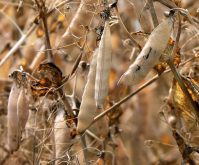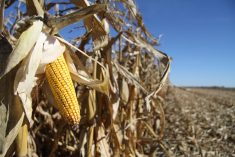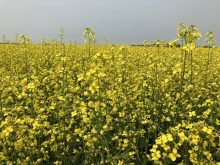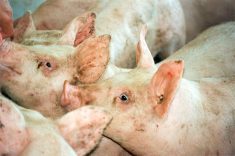Fed cattle dip
Fed steers averaged $101.39, down 75 cents per hundredweight and fed heifers averaged $101.43, down 25 cents last week, said Canfax.
Some producers were unwilling sellers at the lower prices. Packer bid ranges were wide as they got selective heading into a short week.
Volume was down 17 percent from the week before with about 13,500 head sold.
Exports of fed cattle to the United States totalled 9,820 head, the second smallest number since the start of the year, said Canfax.
Alberta prices May 17 were steers $99.20-$102.50 per cwt. and rail $166.70-$168.40 and heifers $101.50.
Read Also

Bond market seen as crop price threat
A grain market analyst believes the bond market is about to collapse and that could drive down commodity values.
Canfax said trade this week might be slow because feedlots were discouraged by end of the week prices.
Even with carryover, feedlots are still current and show lists should be manageable in coming weeks.
Beef movement slow
Beef cut-out prices rose in the U.S. but movement was slow, said Canfax.
Choice and Select cutouts rose $5 US per cwt. The week’s Choice-Select spread was $12.78 compared to the previous week’s $12.81 and last year’s $20.45. Choice ended the week at $166.40 while Select was $153.62.
In Canada, a weather forecast for the Victoria Day weekend limited fill-in buying. Middle meats are seeing good seasonal demand but overall movement is struggling. The Calgary wholesale market was $1-$2 lower for delivery this week at $171-$172.
Feeders strengthen
There was a wide spread in feeder cattle prices based on quality and the number of cattle going to auction.
There was good demand and prices rose, said Canfax.
Light steer calves 300-600 lb. were $1-$2.75 higher and heifers 300-600 lb. were $1-$3 higher.
Steers 600-800 lb. were $1.25-$2.50 higher and heifers 600-800 lb. were $1-$2 higher.
Heavy steers 800-900 lb. were $1.50 higher and steers 900 lb. and heavier were $1.50 lower.
Heifers 800-900 lb. and heavier were steady.
About 29,500 head went through Alberta auction markets, up eight percent from last week and 29 percent from last year, said Canfax.
Strong trade was reported for butcher cows with D1, 2 cows up $5 and D3 cows up $4.75. Butcher bulls rose $4.25.
About 7,800 feeder cattle were exported to the U.S. for the week ending May 12.
Light offerings will continue into the summer with mixed quality available, said Canfax.
Quality cattle will bring a premium, but mostly local buying interest is expected with the strong Canadian dollar narrowing the basis and deterring American buyers.
Bred cows in central and northern Alberta were lower at $800-$1,000, with tops to $1,200 and plain types $550-$750.
Bred heifers in northern Alberta were lower on plain types at $550-$890. Cow-calf pairs traded lower at $850-$1,200, with tops to $1,425 and plain types $500-$800.
Hogs edge higher
Supplies of market-ready hogs in the U.S. have been tight for some time and should remain tight into early June.
Pork plant profits have narrowed, but the margins are still profitable, which should keep hog bids firm. Also helping demand was a few plants had returned to eight-hour shifts from recent seven-hour shifts.
Iowa-southern Minnesota hogs traded May 18 at $55 US per cwt. up from $53.50 May 11.
The U.S. composite pork carcass cut-out value was $77.92 May 18, up from $77.80 on May 11.
Slaughter for the week was estimated at 1.952 million, compared with 1.934 million a week ago and 1.958 million a year ago.
Bison report
Amendments to the bison grading system have been implemented to help ensure that meat from bison heifers and bulls is appropriately graded.
The previous grading system reflected a situation where most animals being slaughtered were bulls. Today, heifers are routinely slaughtered, and the revised standards take into account the slower growth rate of heifers. The amendments extend current markets for bison meat, which may help to increase bison exports.
Prices for quality carcasses are rising as demand grows, said the Canadian Bison Association.
Top quality grade A carcasses from bison bulls younger than 30 months in the desirable weight range in Canada were $1.85-$1.90 per lb. and heifers were $1.65-$1.70 per lb.
Heifer carcasses outside the desired parameter were lower by as much as 25 cents per lb. Grass-finished younger-than-30-month bulls and heifers meeting specific specs saw prices to $2 per lb.
Rail prices for top quality, youthful older-than-30-month bulls and heifers were $125-$145 per cwt.
There was only one price quote for cull cows at 45 cents per lb. hot hanging carcass.
The U.S. Department of Agriculture reported May 10 that carcasses from bulls younger than 30 months rose to an average of $183.98 US per cwt. in April, up from $180.68 in March.
Cull cows fell to $113.06 per cwt. from $115.68 the month before.
Heavy lamb prices rise
Ontario Stockyards reported 1,909 sheep and lambs and 150 goats traded last week.
Heavy lambs sold at strong prices while light lambs were steady. Sheep and goats were firm.
Beaver Hill Auction in Tofield, Alta., reported 672 sheep and 16 goats traded May 14. All fleshy lambs went to slaughter. Poor or thin lamb prices were down. Cull ewes and rams were down by up to $20 per cwt. Goats were steady.
Lambs lighter than 70 lb. were $131-$179 per cwt. Lambs 70 to 85 lb. were $130-$150, 86 to 105 lb. were $116-$157 and 105-119 lb. were $110-$120. Lambs heavier than 120 lb. were $80-$110 per cwt.
Rams were $41-$64 per cwt. and cull ewes $40-$64 per cwt. Bred ewes were $90-$120 per head and families were $100-$250.
Good kid goats were $160-$215 per cwt. Nannies were $71-$91 per cwt. and mature billies were $122.50-$164.















